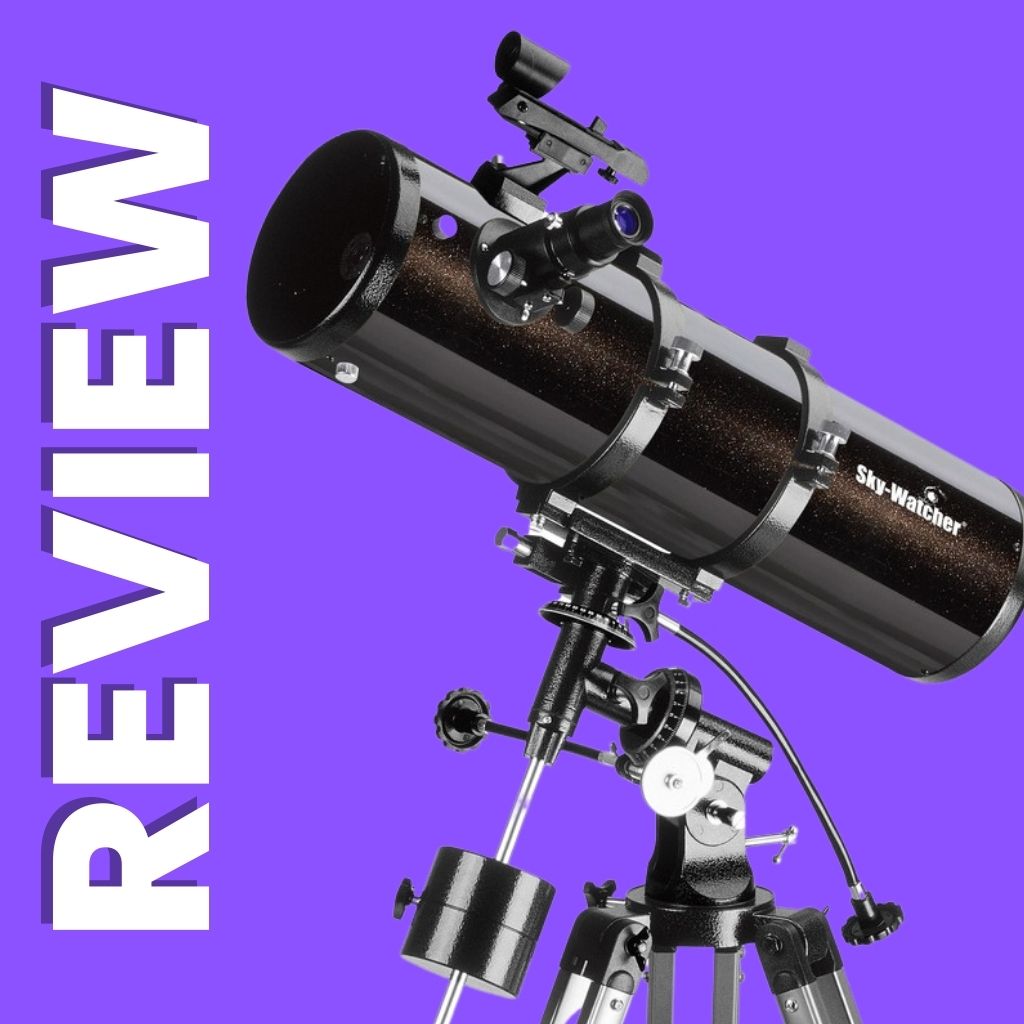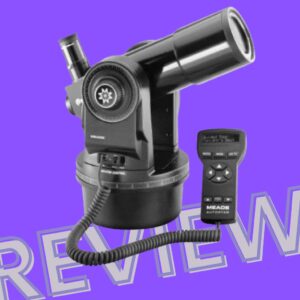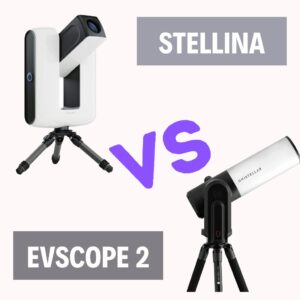This site contains affiliate links to products. I may receive a commission for purchases made through these links.
The Sky-Watcher Explorer 130m is an affordable, well-rounded telescope that astronomy enthusiasts can use to view the nearer solar system objects like the planets and the moon. They can also view farther-deep sky objects like star clusters, galaxies, globular clusters, and nebulae. It comes with an equatorial mount.
The Sky-Watcher Explorer 130m is a smartly-designed telescope with a clear differentiating feature that separates it from other beginner telescopes.
In this article, I discuss the main features of the telescope, the accompanying accessories, its optical quality and performance, its pros and cons, and whether it’s appropriate for beginners and worth investing in.
Sky-Watcher Explorer 130m features and specifications
I’ve summarized the features and specifications of the Sky-Watcher Explorer 130 telescope in the table below.
| Aperture size | 5.1-inch or 130 mm |
| Optical design | Newtonian reflector |
| Focal length | 35.4-inch or 900 mm |
| Focal ratio | f/6.9 |
| Tube weight | 7.5 lbs or 3.4 kg |
| Mount weight | 14.8 lbs or 6.7 kg |
| Tripod weight | 5.5 lbs or 2.5 kg |
| Total kit weight | 26.2 lbs or 12.6 kg |
| Mount type | EQ2 equatorial mount |
Sky-Watcher Explorer 130m accessories
The Sky-Watcher Explorer 130m comes with additional accessories to complement the tube’s optics and usability:
- Tripod: The Explorer 130 from Sky-Watcher comes with an aluminum tripod. At 2.5kg, it is considerably sturdy and durable and adequate for a telescope with a 130mm aperture. The tripod reaches about 4 feet or 1.2 meters off the ground at full extension. The tripod is also collapsible, thanks to the struts across the center.
- Eyepieces: Attached with the Sky-Watcher 130m are two Kellner eyepieces and a Barlow lens. One of the eyepieces supplied has a focal length of 25mm, and the other 10mm.
- Finderscope – Red dot finder: It also comes with a basic 6 x 24 red dot finder. I’ve heard some astronomers talk about the fit of the finderscope with the barrel.
- Counterweight: Due to the telescope’s weight, the Sky-Watcher Explorer 130 comes with a counterweight to keep it balanced while you use it. The counterweight weighs as much as the telescope, about 3.6 kg or 8 lbs. It also means you can add any accessory with reasonable weight without losing balance.
- Accessory tray: There’s an accessory tray where you can keep items or accessories you intend to use while stargazing.
- Equatorial mount: This telescope comes with an EQ mount in luxury design. An EQ mount for a telescope of this range is a bit unusual for a beginner telescope. One reason for that is that it takes time to master them. An EQ mount is unlike an alt-azimuth mount in that it has its polar axis tilted parallel to the earth’s rotational axis. This configuration makes it easier to track objects irrespective of the relative movements between them and the earth.
Sky-Watcher Explorer 130m design and build quality
The Sky-Watcher Explorer 130 is a classical Newton Reflector telescope. In its long tube is a spherical mirror, which doesn’t work as well as a parabolic mirror.
It was nice to find the telescope well-collimated out of the box. If yours isn’t, there’s a good tutorial on collimating the telescope in the manual.
As a reflector telescope, there’s a secondary mirror at the front of the tube to redirect light. This secondary mirror poses an obstruction, potentially reducing the contrast and the amount of light that gets to the primary mirror or aperture.
In the Explorer 130 telescope, the secondary obstruction is 46mm. As a result, you may observe diffraction rings when observing night sky targets.
Regarding build quality, the telescope meets the expected quality for its price point. I mean, for all the good qualities of the equatorial mount, it still suffers from a bit of droop.
You also have to be careful when tightening the bearings on the mount to avoid damaging the same.
Overall, the telescope’s build and design are commensurate with its price.
Sky-Watcher Explorer 130m optics and performance
If you’ve used other beginner telescopes before, you may be slightly surprised by Explorer’s optical performance. I particularly like it because you can use it for general night sky observations.
For a beginner scope, a light-gathering aperture size of 130mm is adequate. It gathers 30% more light than 114mm scopes, which enables you to see more details on even faint deep sky objects.
It has a fairly long focal length (900mm), which allows you to achieve high magnifications. Long focal lengths enable you to get higher magnifications for viewing the planets and the moon.
The Sky-Watcher Explorer 130 has a focal ratio of f/6.9, classified as medium fast. Scopes with lower focal ratios f/4 to f/5 are classified as fast and have lower magnification and a wider field of view. Slow telescopes of f/11 to f/15 focal ratios are the opposite.
This explains the Explorer 130 general purpose use.
I talked about the telescope’s high obstruction earlier. Consequently, you’ll particularly observe reduced contrast and brighter diffraction rings when observing the planets.
Once you introduce the Barlow lens into the equation, you’ll likely observe false color on some night sky objects.
The main question is: what can you see with it?
What can you see in the night sky with the Sky-Watcher Explorer 130m?
You can see all the planets, deep sky targets, and brighter stars with the Sky-Watcher 130mm. The scope has a limiting magnitude of 12.4 and a resolving power of 0.88. Already, you cannot see the dwarf planet Pluto, which currently has a brightness magnitude of 14.5.
But at this magnitude, you’ll see Jupiter and its moons, Saturn, the ring fog in the Lyra, the Andromeda Galaxy, split double stars, and much more.
What magnification can you have on the Sky-Watcher Explorer 130 motorized telescope?
The Explorer 130 EQ2 scope has a maximum useful magnification or highest practical power of 260X. It simply means there’s no significant optical performance to gain beyond this magnification.
You are supplied with two eyepieces that give you two different magnifications to play with. The first eyepiece has a focal length of 10mm and the second 25mm, which provides magnification of 90X and 36X, respectively.
However, with the 2X Barlow lens, you can double the magnification of the eyepieces.
The 25mm eyepiece is more suitable for viewing deep sky targets, while the 10mm is better for making lunar and planetary observations.
You may also like: What Magnification Do You Need To See Planets?
Is Sky-Watcher Explorer 130 easy to set up?
The Explorer 130 motorized telescope is fairly easy to set up, although its weight and size may make it more slightly complex than it ought to be. The manual has enough information to guide you.
As a newbie, the telescope may initially seem tricky, but it’s not overwhelmingly daunting.
The manual’s language and descriptions could have been worded better, but it suffices to help you through the setup process.
Overall, it shouldn’t take more than 20 minutes if you’ve set up a telescope before.
Since we’re talking about setting up the scope, let’s talk about the weight and how it may affect setting up. The telescope, when coupled, weighs 27.8 lbs or 12.6kg. It also has a tube length of over 900mm. It’s not exactly a portable telescope for traveling.
It’s best to assemble the scope and leave it in a particular indoor spot. So, ensure you have space for it. Otherwise, setting it up and decoupling it all the time can get tiring quickly.
Pros and cons of the Sky-Watcher Explorer 130 motorized telescope
The table below summarizes the pros and cons of the Sky-Watcher Explorer 130 telescope.
| Pros of the Sky-Watcher Explorer 130m | Cons of the Sky-Watcher Explorer 130m |
| Equipped with a German equatorial mount with a motor drive to easily track objects in the night sky. | It’s massive and heavy, which makes it difficult to set up or travel with. |
| Fairly good 130mm Newtonian reflector aperture. | The red dot finder is underwhelming. |
| Good value and performance for the price. | May need collimation before your first use. |
| Good resolution and excellent quality viewing to make the night sky enjoyable. | Slight learning curve with the eq mount. |
Is the Sky-Watcher Explorer 130m a good telescope for beginners?
The Sky-Watcher Explorer 130 Motorized telescope is a beginner-friendly telescope with all-around capabilities to view deep sky objects and observe the moon and the planets. It has automatic tracking and the highest useful magnification of 260X.
The motorized equatorial mount makes it easy to track objects in the night sky, removing another layer of hindrance beginners typically endure.
Another reason why it’s beginner-friendly is because of its focal ratio. It’s neither fast nor slow, which means beginners have flexibility as to what they can observe. They are not limited to choosing between viewing deep sky objects or planetary or lunar observation.
The price and performance of the Explorer 130 motorized telescope make it a good option for practicing and learning about astronomy.
Is the Sky-Watcher Explorer 130 motorized telescope worth it?
For its price, the Sky-Watcher Explorer 130m motorized telescope provides incredible value. On top of that, the scope comes with an equatorial mount, which is uncommon among telescopes in this price range.
First off, I think the fact that it comes with a motorized equatorial mount, notwithstanding its affordable price, gives it massive bonus points from the onset.
Then the optical quality lives up to the billing, at least judging it based on the context of its affordable price.
What telescope is similar to the Sky-Watcher Explorer 130m and a good alternative to consider?
The Celestron AstroMaster 130EQ could be a great alternative to the Sky-Watcher Explorer 130M as it shares many similarities, such as a 130mm aperture and an equatorial mount.
It’s particularly recommended for beginners and is an excellent value for the price.
Takeaway: The Sky-Watcher Explorer 130m telescope is the perfect choice for any budding astronomer on a budget
The Sky-Watcher Explorer 130m telescope is a good beginner scope with a good optical performance.
The fact that it comes with a motorized EQ mount makes it even more appealing for astronomy enthusiasts because it makes tracking easier.
If you’ve recently become acquainted with the hobby, this telescope is a good option for you.
You may also like:





